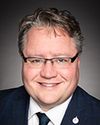Thank you.
My name is Dave Hurwitz. After leaving university, I commercially fished the west coast of Vancouver Island for 17 years. For the past six years, I've been the manager of the Thornton Creek Hatchery, located in Ucluelet on the west coast of Vancouver Island and operated by the Thornton Creek Enhancement Society.
What does a hatchery like ours do?
Each year we spawn, rear and release between 350,000 and over 1,000,000 chinook, chum and coho fry into five streams. We undertake numerous creek walks and snorkel surveys on 10 systems to enumerate salmon returns for DFO's stock assessment division. We also provide DFO with DNA, otoliths, scales and associated biodata for every fish we spawn.
We foster stewardship by delivering the Salmon in the Classroom program in local schools through educational hatchery tours for thousands of visitors and students each year and through open house events. We partner with and provide training for local first nations, local organizations and volunteers.
We participate in the Clayoquot and Barkley roundtables and facilitate West Coast Aquatic, our regional human-wildlife coexistence group, and I am a member of the salmon enhancement and habitat board that is advisory to DFO.
We're presently undertaking a master's project using PIT and coded wire tagging to study west coast Vancouver Island chinook survival, and we have fundraised $70,000 to undertake this research.
Oh, and we repair and maintain a boat, trucks, power lines, an access road, a dam, water supply, three buildings, and incubation, rearing and brood collection equipment. We purchase drysuits, wading gear, safety gear, fish feed, insurance, telephone/Internet and fuel as we travel long distances on gravel roads and by sea to do our work. We have a dedicated crew of five underpaid seasonal workers and several directors and volunteers who are the heartbeat of our organization.
Each year for the past three decades we've received $158,000 from the Government of Canada to operate our hatchery. There is no way that the money Canada provides is enough for hatcheries like ours to do our work. We all rely on donations, grants, partnerships and volunteers.
Inflation and aging infrastructure threaten every hatchery's ability to undertake more salmon enhancement and more tagging and research. Our hatchery is not alone in this regard. The Tofino Hatchery receives only $8,000 per year from DFO to rebuild salmon stocks in remote streams in Clayoquot Sound. This is barely enough to cover the cost of insurance for the vehicle, boat, the building, and liability, and a bit for phone and electricity. Their money is gone before they start.
Science and technology, especially DNA science, teaches us more each year about how to best manage and enhance salmon stocks for resilience. The mass marking of Canadian hatchery fish should be an imperative. We need to be able to measure the success of enhancement and habitat restoration. Mass marking allows for selective fisheries that protect wild stocks while allowing for harvest of hatchery fish. It also provides hatcheries with the ability to ensure genetic integrity when spawning fish from small populations. Mass marking identifies the wildness of a run, allowing individual watersheds to be enhanced to their optimum.
If we were permitted to use DNA parental-based tagging developed by DFO, the cost of mass marking would drop dramatically and would provide more information for science. Most hatcheries have been collecting the necessary data for several years to undertake this paradigm-shifting method of measuring age and determining the origin of hatchery fish.
I am flummoxed by the idea of a Pacific salmon secretariat and restoration centre of expertise. What I do know is that through hatchery enhancement, habitat restoration, research and science-based stock management, we'll improve the state of our salmon.
I also know that DFO has been deeply gutted over the past 15 years. Important positions haven't been filled due to funding cutbacks, and valuable expertise is being lost to attrition. Our incredible community adviser has been covering two positions. Enforcement can use more resources. More watersheds require surveys and biodata collection for stock assessment. The regional DFO staff are our partners, and, like us, they need more funding for boots on the ground.
If we can ensure that the existing hatchery programs are funded to succeed, funding new community hatcheries in critical areas will be a worthy investment in salmon. Now is a crucial time to act on Canada's obligation to conserve our salmon runs. Hatchery enhancement is an effective tool in the tool kit required to rebuild salmon stocks.
Canada absolutely needs to support hatchery enhancement with cost-of-inflation funding increases at the very least, and funding for the mass marking of hatchery salmon.


